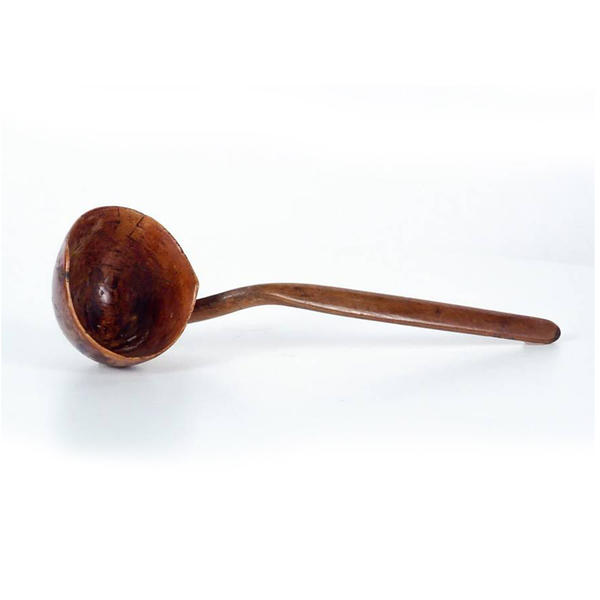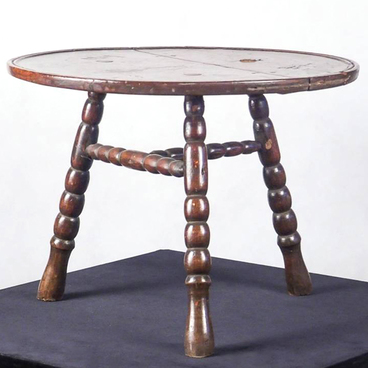The Adyghes preferred wooden, metal and ceramic dishware but most often they would use wooden ware, notably, made from boxwood which is very good for woodworking even with the simplest tools. It is the wood from which the spoon presented in the Museum was made.
For centuries, Kalmyk tea was Adyghes’ most popular drink. It was used to sate not only thirst but hunger as well. A couple of cups of such tea and a piece of fresh home-made bread were enough for a good snack. The rich drink consisted of tea, milk and salt.
As one can guess from the name, the Adyghes borrowed the recipe from their neighbours, Kalmyks. Salty, with a lot of milk and therefore buttery and thick, Kalmyk tea became popular in Central Asia during the Golden Horde times. Up to this day, scholars cannot reliably determine where and when exactly this culinary tradition appeared, but many believe that it was in the Tibet where milk, yak butter and salt were added to green tea.
The basis of the classic Kalmyk drink was brick tea, i.e. pressed green tea. This kind of storage added an especially rich flavour to the tealeaves and made it possible to conveniently transport it when travelling for a long time. The Adyghe drink was brewed using horse dock as a basis to which origanum (dady’u in the Adyghe language) was added for a delicious flavour.
Kalmyk tea ‘Adyghe style’ was brewed in the following way. They took a few, usually 3-4, sprigs of horse dock, rinsed them and put on the bottom of a pan, poured cold water in the pan, brought it to boil and left on a slow fire for a hour until the brew acquired a dark colour. Then the pan was covered with a lid and the brew was left to infuse; 15 minutes later the sprigs were taken out with a straining spoon and the drink was poured to another vessel. Then milk was added, usually one third of the brew volume, and put on fire to boil again. Then salt, black pepper and up to 100 grams of butter were added.
Kalmyk tea was poured into cups with a big wooden spoon, which looked more like a ladle, stirring thoroughly. The custom was to serve the drink hot together with pastry, for example, with guubat, a traditional Adyghe cheese pie from wheat flour.
For centuries, Kalmyk tea was Adyghes’ most popular drink. It was used to sate not only thirst but hunger as well. A couple of cups of such tea and a piece of fresh home-made bread were enough for a good snack. The rich drink consisted of tea, milk and salt.
As one can guess from the name, the Adyghes borrowed the recipe from their neighbours, Kalmyks. Salty, with a lot of milk and therefore buttery and thick, Kalmyk tea became popular in Central Asia during the Golden Horde times. Up to this day, scholars cannot reliably determine where and when exactly this culinary tradition appeared, but many believe that it was in the Tibet where milk, yak butter and salt were added to green tea.
The basis of the classic Kalmyk drink was brick tea, i.e. pressed green tea. This kind of storage added an especially rich flavour to the tealeaves and made it possible to conveniently transport it when travelling for a long time. The Adyghe drink was brewed using horse dock as a basis to which origanum (dady’u in the Adyghe language) was added for a delicious flavour.
Kalmyk tea ‘Adyghe style’ was brewed in the following way. They took a few, usually 3-4, sprigs of horse dock, rinsed them and put on the bottom of a pan, poured cold water in the pan, brought it to boil and left on a slow fire for a hour until the brew acquired a dark colour. Then the pan was covered with a lid and the brew was left to infuse; 15 minutes later the sprigs were taken out with a straining spoon and the drink was poured to another vessel. Then milk was added, usually one third of the brew volume, and put on fire to boil again. Then salt, black pepper and up to 100 grams of butter were added.
Kalmyk tea was poured into cups with a big wooden spoon, which looked more like a ladle, stirring thoroughly. The custom was to serve the drink hot together with pastry, for example, with guubat, a traditional Adyghe cheese pie from wheat flour.



